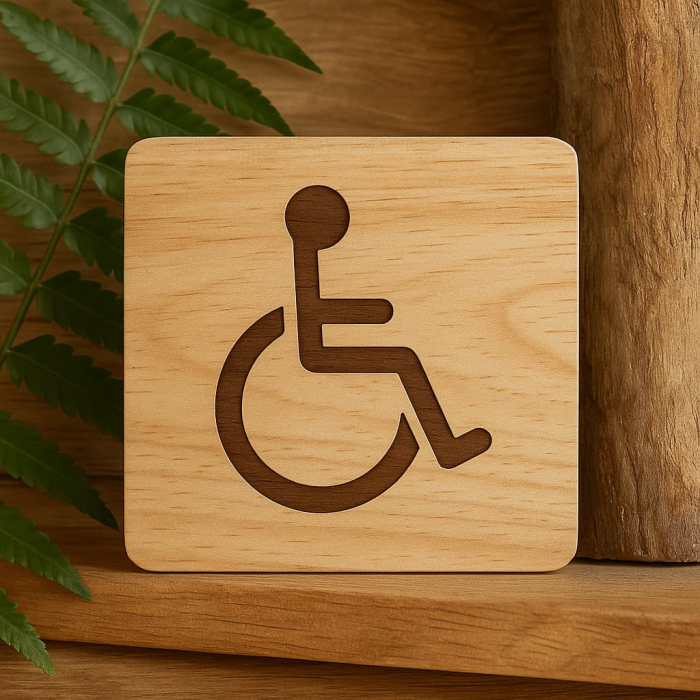A tailor-made solution for every space and every need
Are you looking for PRM signage that reconciles accessibility with natural aesthetics? Wood stands out as an ideal solution, meeting functional requirements while blending harmoniously into various environments. Whatever the type of establishment, a customizable offering ensures signage that is both effective and visually appealing. This approach breaks away from standardized solutions, offering an innovative alternative that’s increasingly popular among environmentally conscious organizations.
From door plates to directional panels: the available variations
Wooden PRM signage covers a wide range of supports. Pictograms (restrooms, elevators, reception desks) adapt to various spaces, while room or office numbers ensure clear identification. Directional signs (arrows, floor indicators) and guiding strips complement the offering, ensuring visual consistency. For example, a wooden PRM restroom door sign shows how a simple element can combine regulatory compliance and elegance. Each component is designed to streamline movement without compromising style, with selected wood types and finishes that increase durability while meeting specific usage constraints.
Where to use wooden PRM signage? Examples of successful integration
Here are some real-world use cases:
In a hotel or tourist residence: Engraved wooden room numbers, spa or restaurant signage, floor indicators.
In company offices: Meeting room plaques, reception signage, service identification.
In a museum or cultural site: Discreet, elegant directional signage, accessible artwork information.
In a healthcare facility: Clear, calming signage to help patients find their way to services and consultations.
In a store: Indication of accessible fitting rooms, priority checkout lanes.
Customization: the key advantage for unique signage
Customization is a powerful asset. You can choose from premium woods such as oak (prestige), beech (brightness), or bamboo (eco-conscious). Finishes — matte varnish or natural oil — preserve the material’s authenticity. Thanks to laser cutting and engraving, each element can include logos, custom fonts, or pictograms aligned with your graphic identity.
Custom wooden signage embodies this approach, combining artisanal precision with technological innovation for a distinctive visual identity. This unique creation process allows you to craft signage that perfectly reflects your brand DNA — all while meeting the highest accessibility standards.
Advanced solutions: wooden signage meets architectural challenges
Stairs and handrails: how to integrate information?
Stairs are critical in terms of accessibility. How do you integrate wood without compromising safety? Wooden sleeves, engraved in braille and with tactile information, fit directly onto handrails.
Positioned at 1.10 m and 1.60 m high, these markers help identify floor numbers or exit directions. Landings can feature clearly visible wooden plaques, while the first and last steps are marked with contrasting wooden elements to prevent missteps.
An often-overlooked detail? A minimum mounting height of 2.20 m for supports — unless they’re visible at less than 1 meter. These are discreet but essential solutions to ensure smart use of space.
The challenge of glass surfaces: elegant and compliant wooden solutions
Glass surfaces can be confusing for users and require a thoughtful approach. You might wonder how opaque wood can meet these needs.
Laser-cut wooden pictograms can be applied directly onto glass using ultra-transparent, high-resistance adhesive. These elements, installed at 1.10 m and 1.60 m from the ground, fulfill vitrophanie requirements while preserving the natural aesthetic.
Glass door frames can also host engraved wooden plaques indicating room names or functions. These solutions — fully compliant with PRM regulations — reduce accident risks while adding a warm, human touch to contemporary spaces.
Outdoor signage: ensuring the durability of wood in all weather
Worried about wood’s resilience outdoors? Here are proven techniques for long-lasting signage:
Choice of wood species: Robinia (false acacia), a naturally Class 4 rot-resistant species, or certified exotic woods are ideal.
Protective treatments: Autoclave treatments or water-repellent saturators prolong wood lifespan, even under intense UV.
Smart design: A geometry that promotes water drainage avoids stagnation that weakens the material.
By applying these best practices, wooden outdoor PRM signage becomes a sustainable, long-term solution. Chestnut or larch, combined with the right treatment, offer a natural design without compromising safety.
Wooden PRM signage combines legal compliance and ecological commitment with natural aesthetics.
Proven techniques (contrast, braille) make it suitable for both indoor and outdoor use. Durable and customizable, it complies with all PRM standards — while enhancing your image as a responsible and forward-thinking organization.


 Whatsapp
Whatsapp

